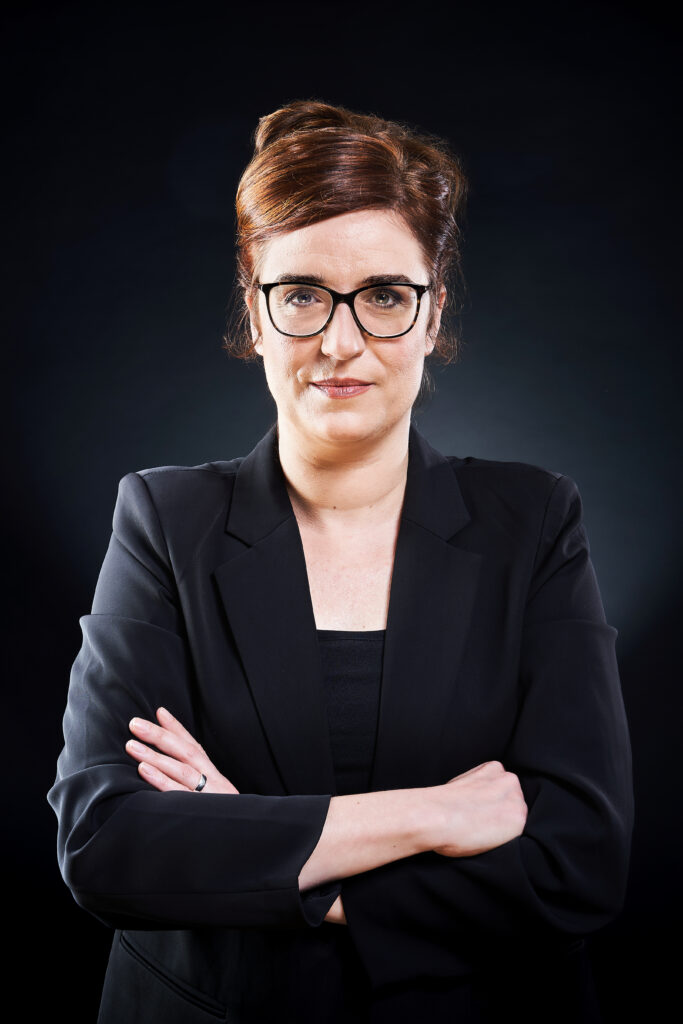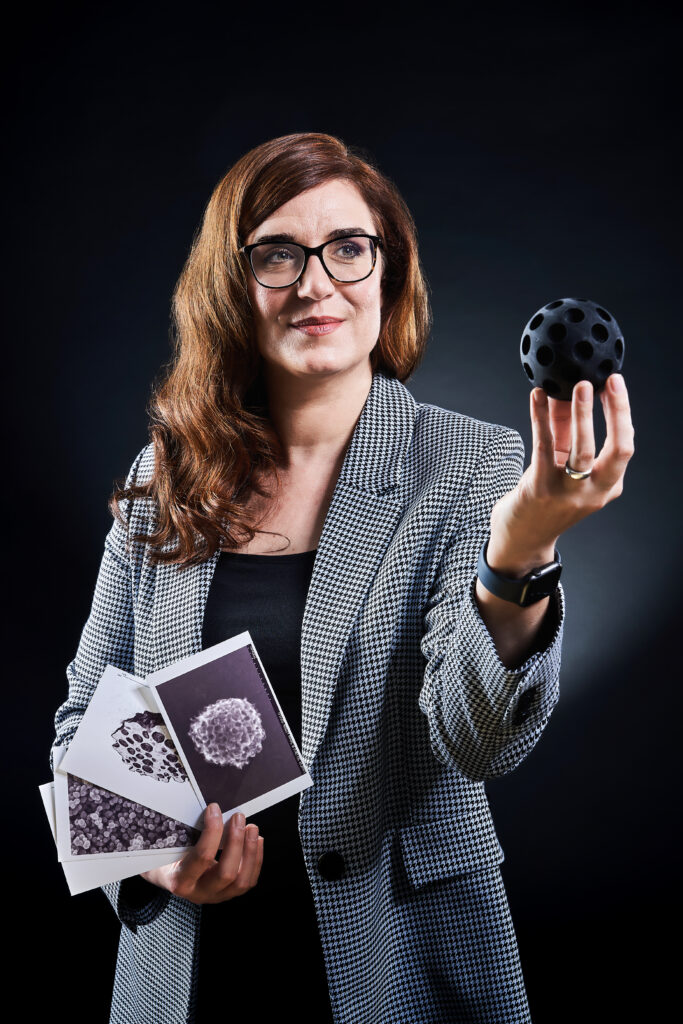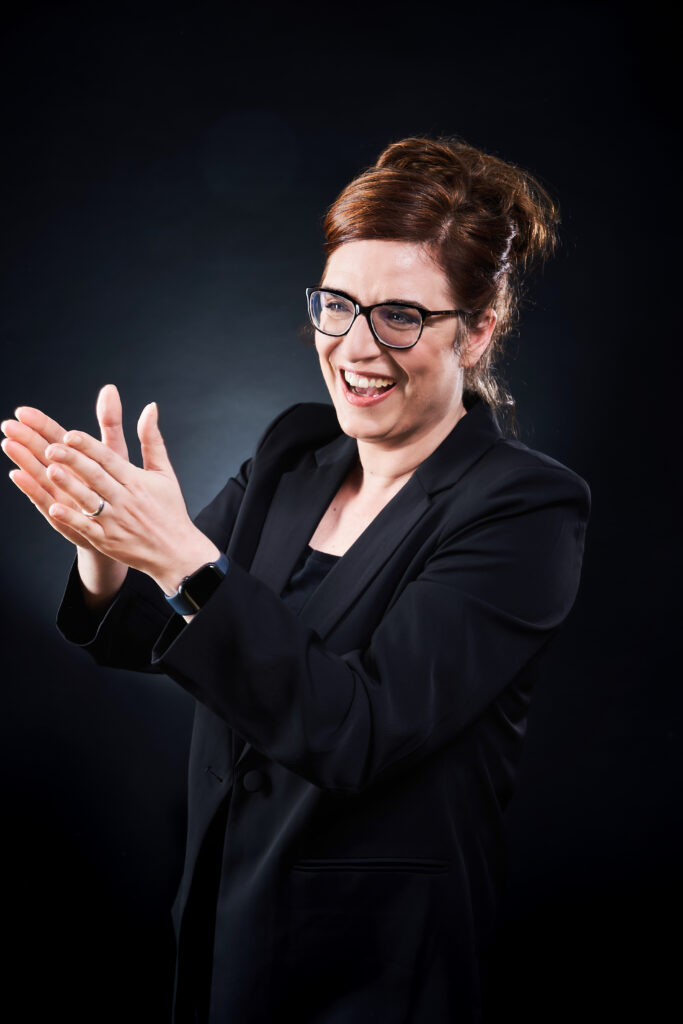About the big and small catalysts in chemistry – Anna Fischer in a portrait

A gloomy day, a huge concrete block stretches out in front of me in all directions. The tops of the gray building complex merge with the cloud-covered sky. Inside the building: long corridors, neon (ghost) lights. The office seems almost like a safe haven. On its wall hangs a whiteboard full of reaction equations, arrows in all directions, no corner untouched by the Sharpie. The office belongs to Anna Fischer, Professor of Chemistry and, in particular, of Inorganic Functional Materials and Nanomaterials, and co-spokesperson of the livMatS (Living, Adaptive and Energy-autonomous Materials Systems) Cluster of Excellence.
She came to chemistry, and nanomaterials in particular, due to a fundamental fascination with everything connecting natural science with technology. Initially, it was mainly outer space („Grandma, someday I’ll fly to the moon with you“), which later led to an interest in physics and chemistry and the realization that „we are all just a well-orchestrated bunch of atoms“. Like Christopher Nolan’s blockbuster „Interstellar,“ her favorite movie, she is all about discovering the unknown and understanding. But what pushed her towards nanomaterials was a professor who, in the last lecture of the semester, suddenly „talked so enthusiastically about his own research,“ the synthesis of highly porous (i.e., permeable and tiny) nanomaterials with gigantic surfaces. And so Anna Fisher came to be the one talking just as excitedly about her research today.
Creating high surface areas in porous or nanoscale materials: what’s the point? Anna Fischer is happy to elaborate on this. Many chemical reactions are slow because a so-called activation energy must be overcome during the reaction. This can be reduced by a heterogeneous catalyst – for example, a material in a different state (solid, liquid, gaseous) -, which means that the reaction takes place with less effort and, above all, faster. Heterogeneous catalysts work best when they provide as much surface area as possible in as little space as possible because this allows more material particles to come into contact with the catalyst and its surface at once. This is precisely the advantage offered by certain inorganic substances on the nanoscale. This may sound very abstract to the layman at first, but it has great practical benefits.
For instance, whenever „green hydrogen“ is talked about as a CO2-free energy carrier for the energy transition, this benefit is revealed. Even though hydrogen is colorless, it has many colors depending on the production process. „Green hydrogen“ is produced starting from water and renewable energies by means of the electrolysis process and can thus contribute significantly as an energy carrier to moving our society away from fossil fuels. Unfortunately, a lot of energy is lost in the current production of green hydrogen, which could be saved largely by using better catalysts. It is also far more expensive than other fossil-based processes, so it is not yet an economical alternative. One reason for this is that platinum- and iridium-based catalysts will be used at the cathode and anode of the electrolyzers (at least in the case of PEM technology).
That’s where nanosurfaces come into play. Their rough structure increases the surface area of the catalyst and improves the utilization of the expensive precious metals. Creating better nanostructures – that’s the goal of Fischer’s work. „You know the ‚what-for,‘ that motivates you,“ the chemist explains, „to help solve the climate crisis technologically – also through improved resource efficiency – that’s the goal.“ Anna Fischer is also thinking about long-term strategies: „We need a circular economy,“ in other words an economic system in which raw materials that have been processed into a product – in the form of a battery, for example – are not disposed of after use, but recycled and reused sustainably.
According to the professor, the possibility of shaping sustainable change in such a way also contributes to the fact that more women in the younger generations are opting for a career in science and technology. There is still a lot of room for improvement in the field of chemistry, where only 22% of professorships are held by women (as of 2021). But thanks to role models like Anna Fischer, things have been changing in recent years. In addition to increased interest in the field of study, which has led to more female students, doctoral candidates and postdocs being active in the field, a change in social discourse has also been an important catalyst. Gender measures have led to a reflection of potential, often unrecognized „unconscious biases in the allocation of positions“ and to qualified female scientists being actively approached (in the sense of proactively seeking candidates) for faculty positions. „Women are much more self-critical than men, and without explicit solicitation, some excellent female scientists would not have applied – despite perfect qualifications.“ Fischer hardly ever observes this phenomenon in male applicants.
One particularly positive development in recent years: more consideration of parental leave. At the beginning of Fischer’s academic career, there were no possibilities for a research group to be compensated for the loss of laboratory work due to pregnancy. As a result, the research group was suddenly missing an important person – often a disaster for new group leaders without their own chair. An uncompensated absence, especially at the beginning of a group leader’s research career, thus represented an enormous risk. Nevertheless, Fischer fought her way through with an all-female research group right at the beginning of her career, clearing all institutional hurdles. Today, there are support mechanisms for just such cases. The support mechanisms are the result of a long struggle for equal rights in research, an important step on a path that is not yet fully paved. Anna Fischer also hopes to make other mechanisms of the German research system more permeable and thus more future-proof, which is why she is strongly committed to promoting young talent in the field of chemistry; regardless of whether that talent is found in laboratory assistants or international postdocs. Those who share her enthusiasm for the subject and have the ambition and motivation to discover the unknown will always find a place in Anna Fischer’s lab.


Portrait by Martin Böckler
Martin Böckler is studying Political Science and Philosophy at the University of Freiburg. In addition to the humanities, he is fascinated by music, chess, grappling and the VelociPastor. Since inhaling fuming hydrochloric acid on his chemitry course, his desire to stand in a laboratory has diminished, but his enthusiasm for the world of particles has remained.